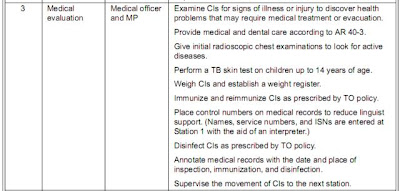An Introduction to Army Regulation
FM-19.40 (19-40)
INTERNMENT / RESETTLEMENT OPERATIONS
First Let Us Define Who a “Civilian Internee” (henceforth to be referred to as a “CI” so as not to confuse with a human being)
“CIVILIAN INTERNEE 1-7. A CI is a person who is interned during armed conflict or occupation if he is considered a security risk or if he needs protection because he committed an offense against the detaining power. A CI is protected according to the Geneva Convention Relative to the Protection of Civilian Persons in Time of War (GC), 12 August 1949.”
ANALYSIS: According to this Military Field Operations Manual, a citizen of the United States (or otherwise, e.g. visitor etc.) who has committed an “OFFENSE” can be imprisoned in a detainment facility (FEMA Camp). Be advised “offenses” that warrant such imprisonment / detainment are NOT SPECIFIED. The manual states that if a commissioned military officer says so, that is all that is necessary.
Here is what the regulation says about that:
AUTHORIZATION TO INTERN
5-4. The internment of protected civilians is authorized and directed if the following requirements are met:
- Internment is necessary (as determined by competent US military authority) for the security of US armed forces in the occupied territory.
- Internment is directed (by a properly constituted US military court in the occupied territory) as the sentence for an offense that violates penal provisions issued by the occupying US armed forces
SECTION 5: DEDICATED TO CIVILIAN INTERNEES (CI’S)
Take the time to carefully read this list of sections. This field manual has covered all the bases.
PROCESSING ACTIONS AT THE “CI” PROCESSING AREA
Let’s examine the PROCESSING of “CI’s” (that’s you and I) once they (we) arrive at the facility via FEMA TRAIN or other transport, shall we?
Here you see the FIRST ACTION and the described process. The first action is called:
SEARCH
- Assign ISNs.
- Follow accountability procedures. Escort CIs and their property. Conduct a same-gender search of CIs before entering the processing area unless prohibited by conditions. NOTE: Upon initial apprehension, a mixed-gender search can be conducted; but it is discouraged due to possible negative repercussions. The same-gender search restrictions are based on the detainee being officially adjudicated and declared a CI.
- Remove and examine property, place it in a container or a tray, mark it with a control number, and take it to a temporary storage area.
- Issue a DA Form 4137 for stored property.
Supervise the movement of CIs to the next station.
First they assign you a NUMBER. Next they perform a SEARCH (a same gender search is necessary as they will be doing a MILITARY STYLE search. They will leave nothing unchecked I can assure you of that.
Next they will have you REMOVE all your property. THIS MEANS CLOTHING. You will be standing there naked in a line with other naked CI’s while they look through your PERSONAL ITEMS and clothing.
Then they will fill out a FORM that lists your personal items and go to the NEXT TASK.
PERSONAL HYGIENE
Next they will ALLOW you, to SHOWER, SHAVE AND GET A HAIRCUT
- Allow CIs to shower, shave, and get haircuts.
- Allow CIs access to sanitation facilities.
- Supervise the movement of CIs to the next station.
REMEMBER YOU ARE STILL NAKED
You have been stripped, searched, and marched naked into the group showers and sanitation facilities. YOU ARE BEING TIMED. They will be RUSHING YOU to hurry up and limit your showers to 1 MINUTE EACH. This is not a picnic folks you are being processed in a CONCENTRATION CAMP.
NAKED – you proceed to the NEXT STEP:
MEDICAL EVALUATION
- Examine CIs for signs of illness or injury to discover health problems that may require medical treatment or evacuation.
- Provide medical and dental care according to AR 40-3. Give initial radioscopic chest examinations to look for active diseases.
- Perform a TB skin test on children up to 14 years of age.
- Weigh CIs and establish a weight register. Immunize and reimmunize CIs as prescribed by TO policy. Place control numbers on medical records to reduce linguist support. (Names, service numbers, and ISNs are entered at Station 1 with the aid of an interpreter.)
- Disinfect CIs as prescribed by TO policy.
- Annotate medical records with the date and place of inspection, immunization, and disinfection.
- Supervise the movement of CIs to the next station.
Medical Evaluation – Step 3.
STEP 4. PERSONAL ITEMS
- Issue personal-comfort items (toilet paper, soap, toothbrush, and toothpaste).
- Ensure that clothing is marked “CI.” NOTE: The CIs must provide their own clothing and footwear.
- Escort CIs to the processing area (Station 5).
Note that you have been NAKED up to this point. You are issued Toilet Paper, Soap, a Toothbrush and Toothpaste. You get your OWN CLOTHES back but they now have the letters “CI” spray painted on them. You better make sure you go there in clothing other than your night gown or you are in DEEP CRAP.
FINGERPRINTING, OTHER PROCESSING, TAKEN TO LIVING AREA
- 6 Photography and fingerprinting
- 7 Personal property
- 8 Records review MP Fingerprint CIs. Identify and record the information on fingerprint cards (DA Form 2663-R).
- Take two photographs (with instant film or digital technology). Have captives look straight ahead, and fill the frame with their face.
- Use photograph name boards (black background with white characters). List ISNs and names (translated into English) at the bottom center.
- Attach one photograph to the CI’s personnel record.
- Give a completed, laminated ID card (which contains the
second photograph) to the CI. - Supervise the movement of CIs to the next station.
MP Inventory and record property (in the presence of CIs) brought from temporary storage areas. - Make separate lists for returned, stored, impounded, and confiscated property. List property to be returned to CIs or stored during internment on a separate list.
- Update DA Form 4137, or provide the CI with a new one. Supervise the movement of CIs to the next station.
- MP Review processed records for completeness and accuracy. Escort CIs back to processing stations to correct errors if necessary.
- Allow CIs to prepare DA Form 2678-R. If CIs are unable to write their own cards, have someone authorized by the commander to do it for them.
- Prepare and maintain an accountability roster of all internees.
- 9 Movement to living area MP Brief CIs on facility rules and regulations.
Escort CIs to their new living areas
YOU GET THE PICTURE













